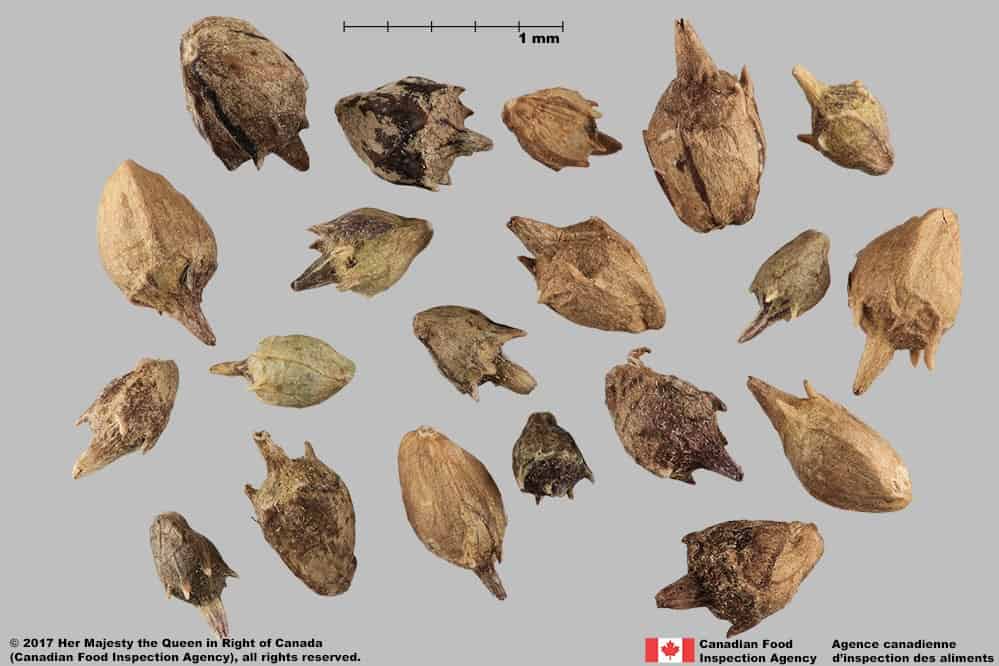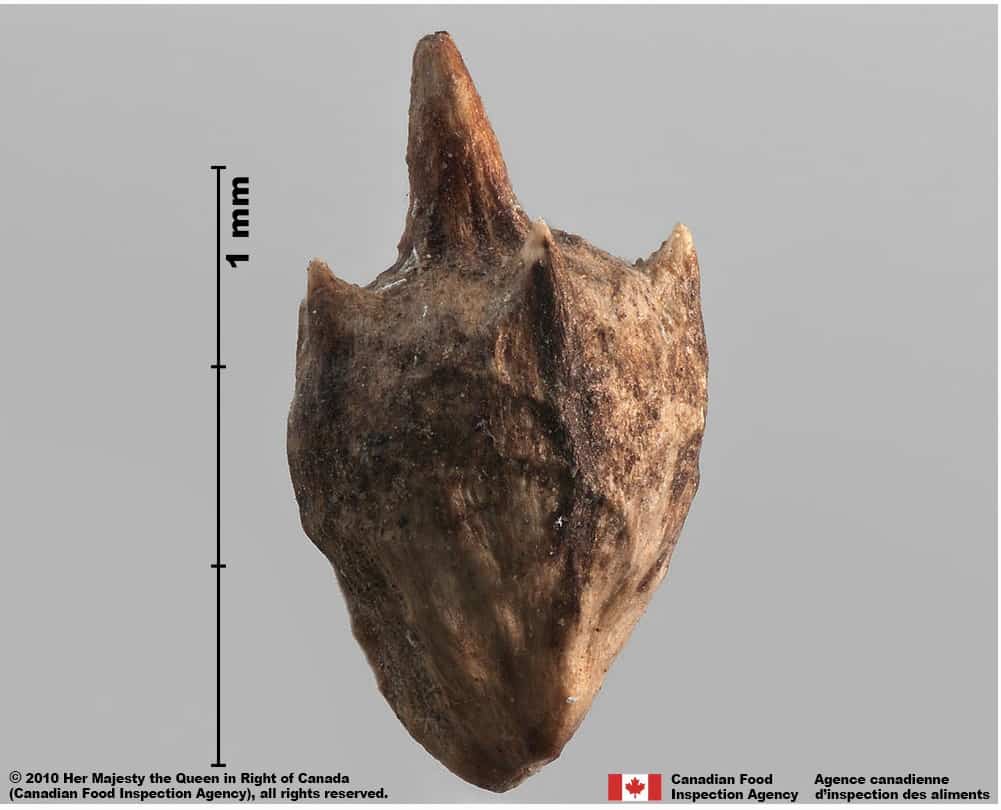Ambrosia psilostachya
Overview
Aperçu
Regulation :
Remarques Réglementation:
- Quarantine lists of countries e.g. India *may be updated without notice
Regulation Notes:
On quarantine lists of countries e.g. India*.
*Quarantine lists of countries may be updated without notice.
Distribution :
Répartition :
This species is native to North America (USDA-ARS 2017). It was introduced to some parts of Africa, Australia, Europe and Brazil (USDA-ARS 2017). In the United States, it is widespread, especially in central and mid-western states (USDA NRCS 2017).
Habitat and Crop Association :
Habitat et Cultures Associées :
Perennial ragweed occurs in dry sandy or rocky soils, abandoned fields, open prairie, forest openings, vacant lots, roadsides, railway embankments and other disturbed areas (Basset and Crompton 1975; Darbyshire 2003).
Economic Use, cultivation area, and Weed Association :
Utilisation économique, zone de culture et association de mauvaises herbes :
Duration of Life Cycle :
Durée du cycle vital:
Perennial
Dispersal Unit Type :
Type d’unité de dispersion :
Achene within a bur
General Information
RENSEIGNEMENTS GÉNÉRAUX
This species does not generally occur in production fields but can form large patches in disturbed areas from creeping rootstock. It is similar in appearance to common ragweed but is distinguished by a perennial habit and horizontal creeping root system, as opposed to an annual habit and tap-root system (Basset and Crompton 1975).
.
Ambrosia psilostachya plant (Joseph M. DiTomaso, University of California – Davis, Bugwood.org)
Identification
Identification
-
Bur
Size
- Bur length: 2.4 – 4.6 mm (average: 3.3 mm); width: 1.8 – 3.2 mm (average: 2.6 mm)
Shape
- Bur and achene are both egg-shaped
- Bur has a short, thick peg at the top of the wide end
Surface Texture
- Bur is woody and smooth with a ring of warts or tubercles near the wide end; may be absent in some burs
Colour
- Bur is dull, light brown to grey-brown

Perennial ragweed (Ambrosia psilostachya) burs




-
Achene
Surface Texture
- Achene surface is smooth
Colour
- Achene is slightly shiny, medium brown
Identification Tips
CONSEILS POUR L’IDENTIFICATION
Additional Botany Information
AUTRES RENSEIGNEMENTS BOTANIQUES

Ambrosia psilostachya seedling (Joseph M. DiTomaso, University of California – Davis, Bugwood.org)

Similar Species
ESPÈCES SEMBLABLES
Similar species are based on a study of seed morphology of various species, and those with similar dispersal units are identified. The study is limited by physical specimen and literature availability at the time of examination, and possibly impacted by the subjectivity of the authors based on their knowledge and experience. Providing similar species information for seed identification is to make users aware of similarities that could possibly result in misidentification.
Ambrosia artemisiifolia (common ragweed)
Common ragweed burs are a similar egg shape and greyish colour as perennial ragweed.
Common ragweed burs are generally smaller (average length: 2.9 mm; average width: 2.1 mm) have thin spines in a ring around the wide end and a thicker, pointed spike at the top of the wide end. Many common ragweed burs have purple streaks.
Click to select species
Cliquez pour sélectionner les espèces

Ambrosia artemisiifolia
Comparison Window
Fenêtre de comparaison
MAIN SPECIES
ESPÈCES PRINCIPALES
Ambrosia psilostachya

Ambrosia psilostachya
Asteraceae
Perennial ragweed (Ambrosia psilostachya) burs
MAIN SPECIES
ESPÈCES PRINCIPALES
Ambrosia psilostachya

Ambrosia psilostachya
Asteraceae
Perennial ragweed (Ambrosia psilostachya) burs
MAIN SPECIES
ESPÈCES PRINCIPALES
Ambrosia psilostachya

Ambrosia psilostachya
Asteraceae
Perennial ragweed (Ambrosia psilostachya) bur
MAIN SPECIES
ESPÈCES PRINCIPALES
Ambrosia psilostachya

Ambrosia psilostachya
Asteraceae
Perennial ragweed (Ambrosia psilostachya) bur wall partially removed showing achene
SIMILAR SPECIES
ESPÈCES SEMBLABLES
Ambrosia artemisiifolia

Ambrosia artemisiifolia
Asteraceae
Common ragweed (Ambrosia artemisiifolia) burs
SIMILAR SPECIES
ESPÈCES SEMBLABLES
Ambrosia artemisiifolia

Ambrosia artemisiifolia
Asteraceae
Common ragweed (Ambrosia artemisiifolia) burs and one seed
SIMILAR SPECIES
ESPÈCES SEMBLABLES
Ambrosia artemisiifolia

Ambrosia artemisiifolia
Asteraceae
Common ragweed (Ambrosia artemisiifolia) bur
Need ID Help?
Besoin d’aide pour l’identification?
Reference(s)
Référence(s)
Bassett, I.J. and Crompton, C.W. 1975. The Biology of Canadian weeds. 11. Ambrosia artemisiifolia L. and A. psilostachya DC. Canadian Journal of Plant Science 55: 463-476.
Darbyshire, S. J. 2003. Inventory of Canadian Agricultural Weeds. Agriculture and Agri-Food Canada, Research Branch. Ottawa, ON.
Flora of North America (FNA) Editorial Committee, eds. 1993+. Flora of North America North of Mexico [Online]. 22+ vols. New York and Oxford. Accessed December 29, 2022.
Global Biodiversity Information Facility (GBIF) Secretariat. 2022. https://doi.org/10.15468/39omei Accessed via https://www.gbif.org/species/3110686 Accessed December 29, 2022.
U.S. Department of Agriculture-Agricultural Research Services (USDA-ARS). 2017. Germplasm Resources Information Network (GRIN), https://npgsweb.ars-grin.gov/gringlobal/taxon/taxonomysearch Accessed April 25, 2017.
U.S. Department of Agriculture-Natural Resources Conservation Service (USDA-NRCS). 2017. The PLANTS Database. National Plant Data Team, Greensboro, NC USA. https://plants.usda.gov/home Accessed April 25, 2017.




